
Revolutionizing Climate Control: Unveiling the World’s Biggest Air Vacuum for Pollution Extraction. Discover its Mechanics!
The cornerstone of efforts to mitigate the elevating levels of greenhouse gases is the recent development of the ‘world’s largest’ vacuum which has been engineered to suck climate pollution right out of the air. This incredible innovation is set to revolutionize the way we counteract the detrimental effects of pollution and climate change. Notably, it is the Orca Direct Air Capture facility based in Iceland, run by Swiss start-up Climeworks, which has claimed this noble mission as its own.
Conceptually, the Orca Direct Air Capture facility operates like an immense vacuum cleaner for carbon dioxide. But the system’s operation is significantly more sophisticated than the average household appliance. The technology behind this vacuum is nothing short of impressive. It includes massive fans that draw ambient air into the system, a process called Direct Air Capture (DAC). Here, CO2 is chemically captured on a highly porous filter that is coated with a substance called amines, which bind CO2 from the air.
After becoming completely saturated with carbon dioxide, this filter moves into a chamber where it is heated to about 100 degrees Celsius. The increased temperature forces the CO2 to unbind from the amines and be collected as concentrated carbon dioxide gas. In effect, this process sucks the CO2 out of the ambient air and isolates it for subsequent storage or utilization.
Carbon dioxide captured in this manner at Orca is transferred to a nearby facility for permanent storage. By employing carbon mineralization as a technique, it is mixed with water and pumped deep underground into basalt rock formations. Here, over a period of one to two years, it reacts with the basalt and transforms into solid minerals, essentially turning into stone. This way, the facility ensures that the captured carbon dioxide is permanently removed from the Earth’s atmosphere.
The capacity of the Orca facility is also worth considering. It has the potential to capture 4,000 tons of CO2 per year. To put this into perspective, this is the equivalent of the CO2 emissions from about 790 cars annually. Although a modest figure in the grand scheme of global emissions, it is predicted that as technology advances and becomes more affordable, facilities like Orca will become more efficient and widespread.
This inclusive system also makes impressive strides towards renewable energy use. The entire facility is powered by geothermal energy, reducing the carbon footprint associated with running such an operation. This makes it a rare example of a completely carbon-negative facility.
One of the most exciting aspects of the

